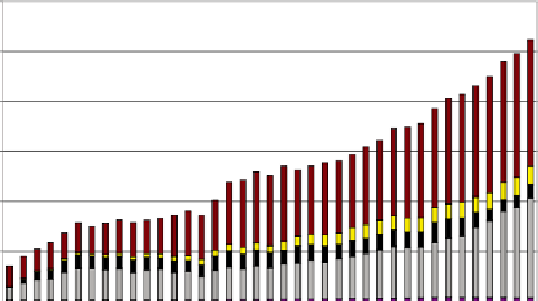Geology Reference
In-Depth Information
following an exponential-like behaviour. Exergy degradation velocity subsequently
increased from around 10 Mtoe/yr at the beginning of the timeframe, until almost
reaching 60 Mtoe/yr in 1968.
The appearance of significant reserves of oil and natural gas (cleaner and easier to
handle fuels than coal), led to an important drop in coal production in the beginning
of the second period (see Fig. 13.27). Nevertheless, the abundance of national coal
stocks, together with the foreseeable depletion of oil, has since provoked further coal
extraction. Meanwhile, iron has gained prominence especially since the beginning
of the 20th century, exceeding the production of oil and natural gas in exergy terms
and reaching extraction figures comparable to those of coal (see Fig. 13.28).
600,000
B*, ktoe
500,000
400,000
Coal
300,000
200,000
N.G.
Oil
100,000
Iron
0
Other metals
Iron
Oil
N.G.
Coal
Fig. 13.27 Natural bonus depletion of the main fuel and non-fuel minerals in Australia from 1969
to 2008
B*, %
100
90
Coal
80
70
60
50
40
30
Oil
20
Iron
10
N.G
.
Other metals
0
1914
1924
1934
1944
1954
1964
1974
1984
1994
2004
Year
Other metals
Iron
Oil
N.G.
Coal
Fig. 13.28 Relative contribution of the extraction of fuel and non-fuel minerals to the global
natural bonus degradation of Australia from 1914 to 2008



























Search WWH ::

Custom Search